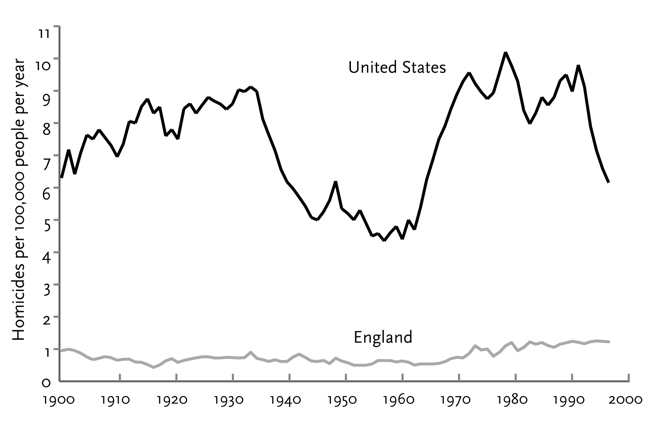And figure two, Homicide rates in US and England 1900-2000, shows that in the 1960s the homicide rate in America went through the roof.

Figure two - Homicide rates in US and England 1900-2000
After a three-decade free fall that spanned the Great Depression, World War II, and the Cold War, Americans multiplied their homicide rate by more than two and a half, from a low of 4.0 in 1957 to a high of 10.2 in 1980 (U.S. Bureau of Statistics; Fox and Zawitz: 2007). The upsurge included every other category of major crime as well, including rape, assault, robbery, and theft, and lasted (with ups and downs) for three decades. The cities got particularly dangerous, especially New York, which became a symbol of the new criminality.
Though the surge in violence affected all the races and both genders, it was most dramatic among black men, whose annual homicide rate had shot up by the mid-1980s to 72 per 100,000.
The rebounding of violence in the 1960s defied every expectation. The decade was a time of unprecedented economic growth, nearly full employment, levels of economic equality for which people today are nostalgic, historic racial progress, and the blossoming of government social programs, not to mention medical advances that made victims more likely to survive being shot or knifed. Social theorists in 1962 would have happily bet that these fortunate conditions would lead to a continuing era of low crime. And they would have lost their shirts.
Why did the Western world embark on a three-decade binge of crime from which it has never fully recovered? This is one of several local reversals of the long-term decline of violence that I will examine in this book. If the analysis is on the right track, then the historical changes I have been invoking to explain the decline should have gone into reverse at the time of the surges.
An obvious place to look is demographics. The 1940s and 1950s, when crime rates hugged the floor, were the great age of marriage. Americans got married in numbers not seen before or since, which removed men from the streets and planted them in suburbs (Courtwright 1996). One consequence was a bust in violence. But the other was a boom in babies. The first baby boomers, born in 1946, entered their crime-prone years in 1961; the ones born in the peak year, 1954, entered in 1969. A natural conclusion is that the crime boom was an echo of the baby boom. Unfortunately, the numbers don’t add up.
If it were just a matter of there being more teenagers and twenty-somethings who were committing crimes at their usual rates, the increase in crime from 1960 to 1970 would have been 13 percent, not 135 percent.[2] Young men weren’t simply more numerous than their predecessors; they were more violent, too.
 Was David Ruffin & Tammi Terrell having nikkas go crazy?
Was David Ruffin & Tammi Terrell having nikkas go crazy? Was David Ruffin & Tammi Terrell having nikkas go crazy?
Was David Ruffin & Tammi Terrell having nikkas go crazy?


